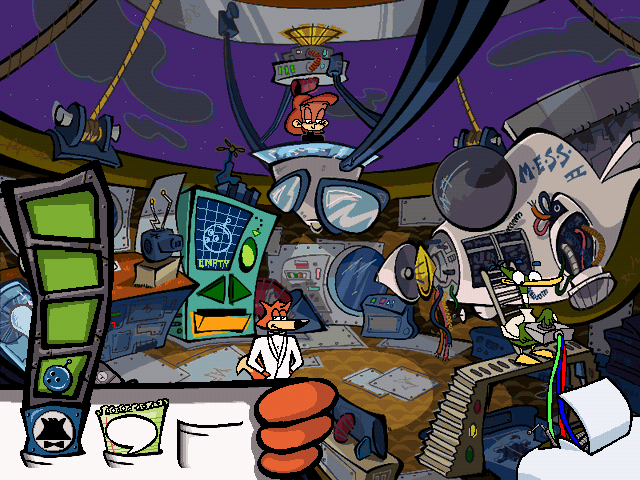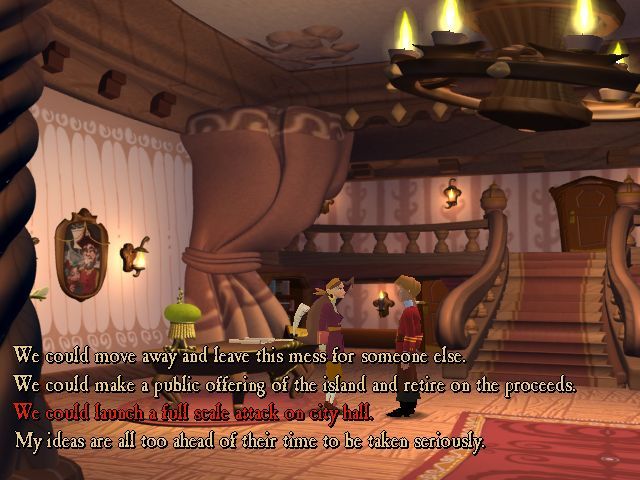Point-and-Click Adventure Games
By Jenna Marvet
Before there were video games, there were all-text games. Enter Colossal Cave Adventure: created in 1976, it was considered the first notable computer text adventure game (Pearson.) Inspired by tabletop Dungeons and Dragons, Colossal Cave Adventure allowed players to explore a large cave network with fantasy and puzzle elements using text-based commands (Jerz.) Colossal Cave Adventure utilized a description of connected rooms the player moved through using responses like “n” for north and “d” for down (Wolf, “MYST” 8.)
Colossal Cave Adventure Walk-Through
Text adventures like Colossal Cave Adventure laid the groundwork for future adventure computer games, such as point-and click adventure games. The main aspects that were adopted were the idea of a navigable space composed of combined rooms, characters which a player could interact with for brief conversations and the use of objects to give players access to new areas (Wolf, “MYST” 9.) These building blocks can be seen in adventure games throughout the following history. As technology evolved, so did computer games. Improvements in hardware, software, processing speed and memory made possible the evolution from text adventures, to graphic Atari 2600 adventure games, to photorealistic and 3D CD-ROM adventure games (Wolf, “Inventing Space” 12.) In fact, Colossal Cave Adventure itself evolved into Adventure for the Atari 2600 in 1978 (Jerz.)
Atari 2600 
In 1987, Ron Gilbert and Aric Wilmunder created the Script Creation Utility for Maniac Mansion (SCUMM,) a story development system. Maniac Mansion is a LucasArts graphic story game parodying bad horror movies in which players manipulate three teenagers to save “Sandy the Cheerleader” from a doctor controlled by an evil monster (Crockford.) SCUMM organized narrative elements “at the level of code within a database of discrete spaces.” The SCUMM framework allowed for a user-friendly narrativity connecting player actions with visual representations of story elements (Black 213.)
Maniac Mansion In-Game Screen 
In essence, SCUMM is an assembly language which was created to abstract gameplay. Abstraction streamlines code and allows for increased ease of reusability (Dip.) Its reusability allowed for the creation of a number of other successful LucasArts computer adventure games for many years to follow such as The Secret of Monkey Island and Indiana Jones and the Fate of Atlantis (Cobbett.)
SCUMM Example
Also in 1987, the CD-ROM became increasingly popular for adventure game developers. CD-ROMs allowed for more memory space, meaning better graphics, sound and integrated video clips. In 1993, cultural phenonmenon Myst was released as an adventure game on CD-ROM discs. It became a huge success in the gaming world and released a number of sequels. Over 100,000 copies of Myst were sold by the end of 1993 and the game was praised for its “photorealistic” computer-generated graphics (Wolf, “MYST” 17.) In Myst, players assume the role of the “Stranger” and use magical books to travel throughout a lonely, but beautiful island. Throughout the game, players solve puzzles to move along in the relatively low-stakes story (Encyclopaedia Britannica.)
Myst Walkthrough
Around the same time in 1992, Ron Gilbert, one of the key creators of SCUMM, and Shelley Day founded Humongous Entertainment after working at LucasArts. Humongous applied narrative, character and world-building to children’s edutainment CD-ROM games. Humongous’ Junior Adventure series included hit series like Putt-Putt, Spy Fox and Freddi Fish. Though aimed at young audiences, these games utilized similar structures to adult point-and-click games, such as inventories and object-based puzzles to gain access to gated areas (Clark.)
Spy Fox: Operation Ozone In-Game Screen 
In the late 1990s, point-and-click adventure games began to move away from their 2D graphics to a 3D style. By 2001, LucasArts had transitioned from the SCUMM engine and released its final adventure game, signaling the end of an era for the genre (Kaser.)
Escape from Monkey Island, LucasArts’ final adventura game release 
Fans consider the 1980s and 90s the “Golden-Era” for point-and-click adventure games, especially pointing to the styles present in games like The Secret of Monkey Island. The early 2000s have been titled “the Dark Ages,” and the mid-2000s a nostalgic “Renaissance” (Kaser.) However, while point-and-click adventure games have never returned to the level of cultural phenomenon they were in their golden year, the aesthetic of their design seems to have been graphic growing pains while technology evolved.
Syberia is considered a gem from the point-and-click adventure game “Dark Ages.” 
When considering the demise of the point-and-click adventure game genre, one nostalgic fan explained that, while the games might be charming, they also can lead to infuriation. Because specific actions or clicks are required to move the plot forward, playing such games can lead to an endless spew of attempts at clicking the right pixel or using the right object without success (Jefferson.)
However infuriating at times, point-and-click games have evolved over time as technology has changed. Few households still utilize desktop PCs, which many of these games were built for. Not to mention, computer mice, the main tool for pointing and clicking, are things of the past. While Steam and emulators make playing older games on modern devices possible, video games have evolved, surpassing the monotony of pointing and clicking. The simplicity seems antiquated in comparison. The spatial design theory is perhaps one of the classic point-and-click game’s most lasting legacies in video games today, beyond the charming sense of nostalgia they generate for many.
Bibliography
Black, Michael L. “Narrative and Spatial Form in Digital Media: A Platform Study of the SCUMM Engine and Ron Gilbert’s The Secret of Monkey Island.” Games and Culture 7, no. 3 (May 2012): 209–37, https://journals-sagepub-com.ezproxy.wlu.edu/doi/full/10.1177/1555412012440317#_i3.
-The author explains the history behind the creation of the SCUMM framework as well as how it actually functioned. He focuses on how SCUMM allowed for the focus on narrative through code. The focus is on how certain interactions with in-game objects connect with narrative movement, creating a feeling of literary reading in game play.
Clark, Nicole, “From ‘Putt Putt’ to ‘Freddi Fish’-How Humongous Entertainment Made Edutainment Fun,” Vice, May 9, 2019, https://www.vice.com/en_us/article/xwnwya/from-putt-putt-to-freddi-fishhow-humongous-entertainment-made-edutainment-fun.
-The author recounts the history of Humongous Entertainment, the creator of the children’s edutainment adventure series. Especially notable is the connection to LucasArts, one of the originators of the computer-based adventure game, as well as the use of similar in-game practices to adult adventure games. This source uses interviews with the founders of Humongous Entertainment, one of which is the founder of SCUMM, a framework used in a number of successful adventure games. This evolution shows how pervasive the adventure game genre was across audiences.
Cobbett, Richard. “The Rise, Fall, and Rebirth of LucasArts’ Adventure Classics.” Vice, January 28, 2015. https://www.vice.com/en_us/article/kwpd7v/the-rise-fall-and-rebirth-of-lucasarts-adventure-classics-883.
-This article recounts the history of LucasArts, one of the originators of the point-and-click adventure game. A series of notable games are revisited by the author, outlining the changes in the company’s output overtime. LucasArts is seen by many as the pioneer who perfected the point-and-click adventure game genre.
Crockford, Douglas. “The Untold Story of Maniac Mansion.” Wired. Conde Nast, December 14, 2017. https://www.wired.com/1993/04/nintendo-2/.
-Crockford recounts his time working on Maniac Mansion at LucasArts, making this a primary source. He discusses the behind-the-scenes drama behind creating the game that defined a generation of adventure gaming. Also notable is his reference to the creation of SCUMM during his time working on the project.
Dip, Roberto. “SCUMM Internals and Syntax for the Sake of Nostalgia.” Monades. Accessed May 8, 2020. https://www.monades.dev/scumm-internals-syntax/.
-The author reflects on the SCUMM language originally created by LucasArts for Maniac Mansion. He outlines how the language streamlined adventure game production and allowed for multi-tasking in graphic representation. This source gives an inside-look to one of the core moments of adventure gaming history, showing how the code functioned inside the game.
Jefferson, Ed. “The Rise and Fall of the Point-and-Click Adventure Game,” The New Statesman, January 7, 2019, https://www.newstatesman.com/culture/games/2019/01/rise-and-fall-point-and-click-adventure-game.
-The author reflects on his nostalgic past of classic point-and-click adventure games. He describes why he believes the genre declined, noting that the games were incredibly frustrating in how they were coded. The games were sometimes too difficult because the actions to move the narrative forward were often incredibly specific, partially due to technological limitations.
Jerz, Dennis G. “Somewhere Nearby is Colossal Cave: Examining Will Crowther’s Original “Adventure” in Code and in Kentucky,” Digital Humanities Quarterly 1, no. 2 (2007), Accessed May 7, 2020. https://www.digitalhumanities.org/dhq/vol/001/2/000009/000009.html.
-Jerz writes on the history of one of the original text adventure games, Colossal Cave Adventure. He describes the interface which allows for the movement through a number of connected rooms in a large cave system. He further compares this to the actual cave the game was based on, noting the accuracy in the creator’s digital representation of nature. This piece shows the relationship between the coding of adventure games and space, one of the clear patterns in how scholars are discussing this piece of video game history.
Kaser, Rachel. “The Dark Age of Adventure Games – and the Gems It Produced.” The Next Web, April 8, 2019. https://thenextweb.com/gaming/2019/04/06/adventure-games-gems-dark-age/.
-The author constructs the “eras” of the point-and-click adventure game, from the “golden age” to the “dark age” and “revival.” As the 1990s concluded, these games entered the “dark age” era, altering the genre to focus on a less charming 3D style with less mouse-driven action. This era was also the time when LucasArts produced its last adventure game, signaling the demise of the genre’s golden era.
Pearson, Jordan. “The First Text Adventure Game Ever Is Finally Open Source.” Vice, May 29, 2017. https://www.vice.com/en_us/article/ywmyn5/the-first-text-adventure-game-ever-is-finally-open-source.
-The Colossal Cave Adventure code was released as open source code in 2017. Having been published in the 1970’s, this allowed for developers to finally work to improve the code and upgrade it for modern-day machines. This action shows how deeply rooted Colossal Cave Adventure is in gaming history, and the nostalgia gamers still hold for these original styles of adventure gaming.
The Editors of Encyclopaedia Britannica, “Myst,” Encyclopædia Britannica. Encyclopædia Britannica, inc., August 18, 2011, https://www.britannica.com/topic/Myst.
-While this is a typical Encyclopedia entry discussing the backstory of the popular computer game Myst, its analysis of the release is particularly interesting. The game was incredibly popular, despite not being heavy in violence at a time when those games were at the forefront. Myst stayed a best-selling computer game for many years, and changed the landscape of adventure games as one of the first and most popular releases on a CD-ROM with then-realistic graphics.
Wolf, Mark J.P. “Inventing Space: Toward a Taxonomy of On- and Off-Screen Space in Video Games.” Film Quarterly 51, no. 1 (1997): 11-23. Accessed May 8, 2020. www.jstor.org/stable/1213527.
-Wolf, a communications scholar with a focus in video gaming, recounts the history of adventure gaming in relation to how the design deals with space. He notes that, as technology improved, the ability to move through space in adventure gaming did as well. This article is helpful in understanding the evolution of technology and design within the world of adventure gaming.
Wolf, Mark J.P. “MYST AND THE ADVENTURE GAME GENRE.” In Myst and Riven: The World of the D’ni, 7-21. ANN ARBOR: University of Michigan Press, 2011. Accessed May 8, 2020, www.jstor.org/stable/j.ctv65sx38.6.
-Wolf discusses the history of adventure game. He begins with Colossal Cave Adventure, noting how its formula inspired future point-and click adventure games. The Colossal Cave Adventure inspired the understanding of spatial movement, object-usage and character interactions in adventure gaming. From there, he shows the path which led to the creation of Myst in the mid-1990s, which came at a time when technology improved significantly allowing for greater graphics and sound in adventure gaming.
